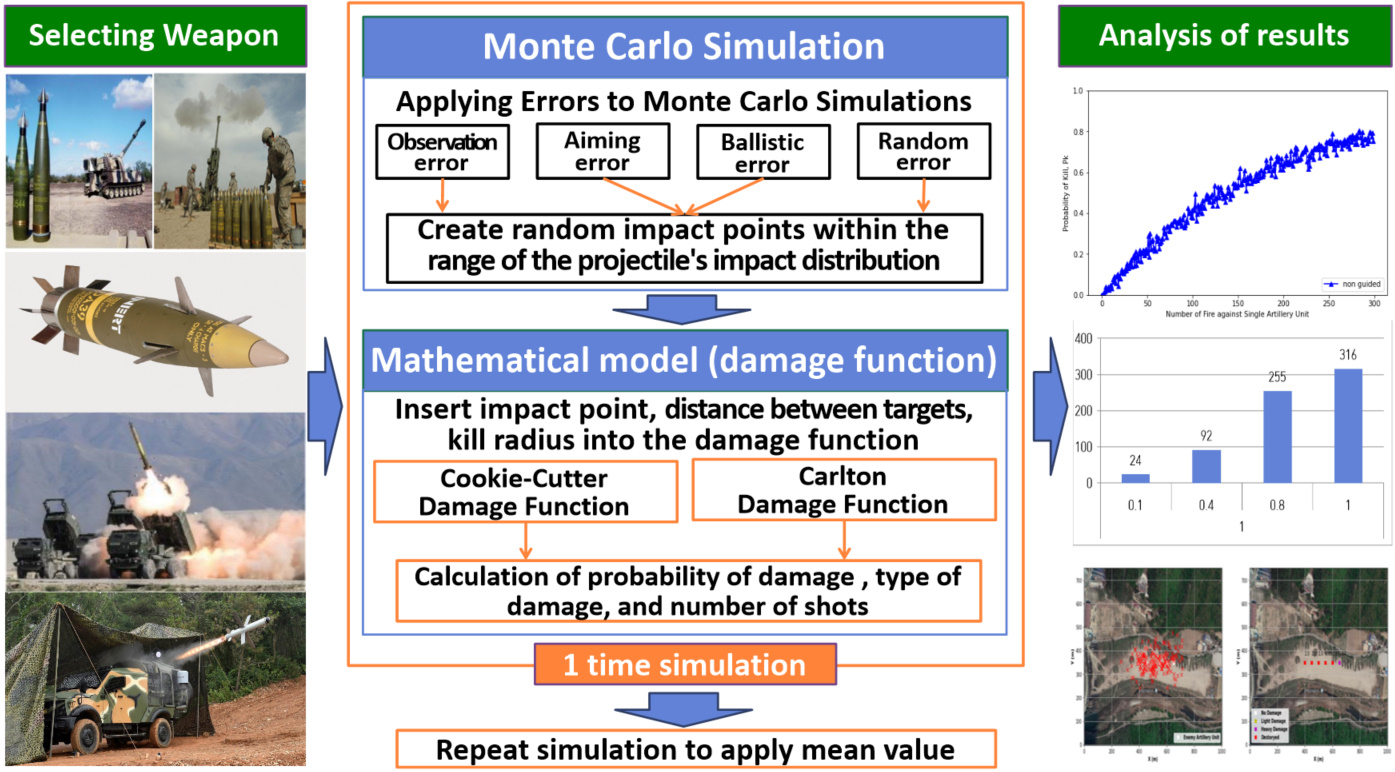Combat effectiveness and efficiency evaluation of firearm weapon systems in different projectile guidance simulations
DOI:
https://doi.org/10.37944/jams.v6i1.196Keywords:
firearm weapons system, monte carlo simulation, probability of kill, carlton damage function, cookie-cutter damage function, counter-artillery fire, combat effectiveness and efficiency, precision of the weapon system, projectile guidance methodAbstract
We analyze the combat effectiveness and efficiency of the firearm weapon systems with stochastic simulations approach. Such combat effectiveness and efficiency are related with the precision of weapon systems, but the precision varies greatly depending on the projectile guidance method of the weapon system. Thus, this study conducted a stochastic simulation based on a mathematical model considering different projectile guidance methods. The simulation was designed assuming Counter-Artillery Fire, which is an important battle that must be successful in order to achieve a firepower advantage in the early stages of the war, and is suitable for judging the combat effectiveness and efficiency due to the precision of the firearm weapons system. Combat effectiveness and efficiency are judged as the result of damage probability, damage type, and desired shooting frequency, and damage probability and damage type represent combat effectiveness, and desired shooting frequency represents efficiency. The simulation environment deployed and simulated an enemy artillery unit with a size of 1,000m × 750m in the target area (6 guns), and applied the killing range of each firearm weapon system. For the description of the damage, the mathematical models Carlton damage function and the cookie cutter damage function were applied, and Monte Carlo simulation was applied to simulate the uncertainty of the battlefield. The results of the present study can be provided basic data to effectively operate and plan the firearm weapon systems.
Metrics
References
Baik, S. W., & Jo, S. S. (2016). Optimization of Engagement Strategy for Counterfire warfare using Heuristic Algorithm. Korean Journal of Military Art and Science, 72(1), 249-264. https://doi.org/10.31066/kjmas.2016.72.1.010
Binder, K., Heermann, D., Roelofs, L., Mallinckrodt, A. J., & McKay, S. (1993). Monte Carlo simulation in statistical physics. Computers in Physics, 7(2), 156-157. https://doi.org/10.1063/1.4823159
Bortz, A. B., Kalos, M. H., & Lebowitz, J. L. (1975). A new algorithm for Monte Carlo simulation of Ising spin systems. Journal of Computational Physics, 17(1), 10-18. https://doi.org/10.1016/0021-9991(75)90060-1
Driels, M. R. (2004). Weaponeering: conventional weapon system effectiveness (pp. 300-302). Reston, VA: American Institute of Aeronautics and Astronautics. Retrieved from http://weaponeering.com/TOC.pdf
Gouveia, H., & Borges, J. (2023). The Future of Field Artillery Projectiles: New Technologies, Strengths and Challenges. In: Rocha, Á., Fajardo-Toro, C.H., Riola, J.M. (eds) Developments and Advances in Defense and Security. Smart Innovation, Systems and Technologies, vol 328. Springer, Singapore. https://doi.org/10.1007/978-981-19-7689-6_30
Kim, J. W., & Ahn, N. S. (2020). Monte Carlo Simulation based Optimal Aiming Point Computation Against Multiple Soft Targets on Ground. JOURNAL OF THE KOREA SOCIETY FOR SIMULATION, 29(1), 47-56. https://doi.org/10.9709/JKSS.2020.29.1.047
Kim, S. Y. (2008). A study on the mine artillery striking method using agent based agent based modeling & simulation. Korean Operations Research and Management Science Society Conference, 359-363. https://koreascience.kr/article/CFKO200811850424986.page?&lang=ko
Lim, J. W., & Lee, T. E. (2012). The Study on Analysis of Counterfire Warfare by Utilizing Simulation: Emphasis on Tactical Operation). The Korean Operations Research and Management Science Society Conference, 2257-2263. https://www.dbpia.co.kr/pdf/pdfView.do?nodeId=NODE01959662&googleIPSandBox=false&mark=0&ipRange=false&ac
cessgl=Y&language=ko_KR&hasTopBanner=true
Oh, D. H., & Joo, K. S. (2022). Methodology for Requirement Analysis of MLRS Munition. Journal of Korea Academia-Industrial Cooperation Society, 23(11), 247-255. https://doi.org/10.5762/KAIS.2022.23.11.247

Downloads
Published
How to Cite
Issue
Section
License
Copyright (c) 2023 Journal of Advances in Military Studies

This work is licensed under a Creative Commons Attribution 4.0 International License.

This work is licensed under a Creative Commons Attribution 4.0 International License.

이 저작물은 크리에이티브 커먼즈 저작자표시 4.0 국제 라이선스에 따라 이용할 수 있습니다.






